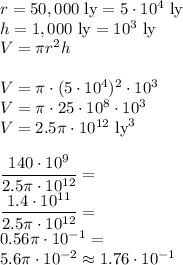
Mathematics, 24.08.2019 14:00 61497
Need with a problem. for some reason i can not seem to get it correct. thinking my formula is wrong. here's the problem:
assume that there are approximately 140x10^9 stars in our galaxy.
our galaxy is 50,000 light years from the center to the edge, but just 1,000 light years thick. it's shaped like a thin disk or cylinder. if the stars were distributed equally throughout the galaxy, how many stars would you expect to find in one cubic light year?
i thought it would be pi*r^2*l. then divide that by the number of stars. what am i doing wrong? , been 20 years since i had to do math like this!

Answers: 3


Another question on Mathematics

Mathematics, 21.06.2019 13:20
What should be done to solve the equation? x+14=21 add 14 to both sides of the equation. subtract 14 from the left side of the equation. add 14 to the left side and subtract 14 from the right side of the equation. subtract 14 from both sides of the equation.
Answers: 2


Mathematics, 22.06.2019 01:10
|2x - 6| > 10 {x|x < -8 or x > 2} {x|x < -2 or x > 8} {x|-2 < x < 8}
Answers: 2

You know the right answer?
Need with a problem. for some reason i can not seem to get it correct. thinking my formula is wrong...
Questions

Mathematics, 12.02.2021 03:40



Chemistry, 12.02.2021 03:40


Arts, 12.02.2021 03:40

History, 12.02.2021 03:40




Mathematics, 12.02.2021 03:50

Mathematics, 12.02.2021 03:50



Spanish, 12.02.2021 03:50


Biology, 12.02.2021 03:50



Mathematics, 12.02.2021 03:50




